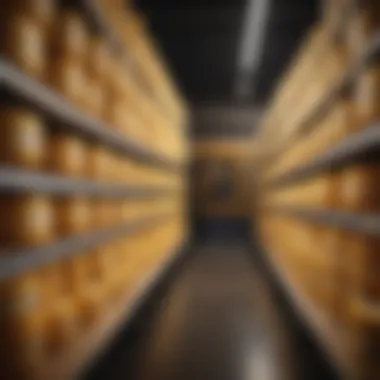Shelf Life of Sargento Cheese: Storage Insights


Intro
Understanding the shelf life of Sargento cheese is critical for consumers, chefs, and culinary enthusiasts. This type of cheese, known for its rich flavors and versatile applications, requires careful consideration for storage to maintain its quality. The key factors affecting shelf life range from packaging types to specific storage methods, which play a significant role in ensuring the cheese remains safe and palatable. By illuminating these details, individuals can make informed choices, optimizing their culinary experiences while minimizing waste.
Key Concepts and Terminology
Basic Definitions
Before delving deeper into the complexities of cheese storage, it is important to understand a few basic terms:
- Shelf Life: This is the period during which cheese remains safe to eat and maintains its desired quality. Factors such as temperature, humidity, and exposure to air can influence this duration.
- Packaging: The type of packaging used plays a pivotal role in preserving cheese. Common packaging options include vacuum-sealed bags or airtight containers.
- Moisture Content: Different cheeses have varying moisture levels. For instance, Sargento’s shredded varieties tend to have a higher moisture content which can affect longevity.
Historical Context
The evolution of cheese storage techniques is rooted in necessity. Historically, the preservation of dairy involved rudimentary methods, often relying on salting or refrigeration in cool climates. Ultimately, as technology advanced, so did the packaging options. Nowadays, innovations such as modified atmosphere packaging have emerged, which can significantly extend the shelf life of cheeses like those produced by Sargento. Understanding this context allows consumers to appreciate modern practices within a historically rich framework.
Recent Innovations and Trends
Technological Advancements
Recently, advancements in food technology have changed how we view cheese longevity. Sargento Cheese has adapted to these trends by utilizing specially designed packaging that enhances freshness. Innovations like vacuum sealing and barrier films protect cheese from environmental changes, effectively extending its shelf life and preserving flavor.
Sustainable Practices
Another important trend is the shift toward sustainable and eco-friendly practices in cheese production and packaging. Sargento has recognized the need for environmentally responsible methods. This approach not only appeals to conscious consumers but also contributes positively to the overall supply chain.
Practical Applications and Techniques
Step-by-step Guides
To maximize the shelf life of Sargento cheese, consider the following effective storage strategies:
- Refrigeration: Always store your Sargento cheese in the refrigerator as it helps inhibit bacterial growth.
- Airtight Containers: Transfer cheese to airtight containers if the original packaging is opened. This reduces moisture loss and protects against odor absorption.
- Avoid Cross-Contamination: Use clean utensils when handling cheese to prevent contamination from other foods.
- Monitor Temperature: Keep your refrigerator at a steady temperature of around 34°F to 40°F (1°C to 4°C).
Case Studies
Real-life examples can illustrate the successful application of these techniques. A culinary professional shared their experience using Sargento cheese in a catering event. They emphasized the importance of proper storage, noting that cheeses stored in airtight containers retained their flavor and texture far longer than those left in their original packaging. Such practical insights reveal the vital role of informed cheese storage in everyday culinary practices.
"Proper cheese storage is as crucial as the quality of the cheese itself. It can make or break the final dish." — Culinary Expert
Through this comprehensive exploration, the aim is to equip readers with a profound understanding of Sargento cheese's shelf life, the intricacies of storage practices, and the realities behind common misconceptions.
Foreword to Sargento Cheese
The exploration of Sargento cheese is significant for both culinary enthusiasts and agricultural professionals. Understanding this cheese not only enhances cooking techniques but also highlights the importance of dairy products in our diets. Sargento cheese, a brand renowned for its quality and flavor, offers a wide variety of cheese products. This article aims to educate readers on the intricacies of Sargento cheese, including its different types, storage recommendations, and shelf life.
Overview of Sargento Products
Sargento Foods has a rich history, established in 1953 with a focus on producing premium cheese products. Their offerings include sliced cheeses, cheese shreds, and cheese snacks. Each product is crafted using specific manufacturing techniques that preserve flavor and texture. Sargento's commitment to quality is evident in the selection of their ingredients.
Apart from traditional cheeses, Sargento also caters to various dietary needs. Their products range from sharp cheddar to mild mozzarella, appealing to a broad audience. By providing a mix of flavors, Sargento encourages creativity in culinary practices.
When choosing Sargento products, consider factors like taste preference and daily diet requirements. Incorporating Sargento cheese into meals can elevate flavors while ensuring nutritional benefits.
Common Varieties of Sargento Cheese


Sargento offers several popular varieties that are staples in many kitchens. These include:
- Sliced Cheddar: Known for its sharp flavor, this cheese is versatile for sandwiches and cheese boards.
- Colby-Jack: A fusion of Colby and Monterey Jack cheese, it’s mild and creamy, suitable for recipes needing a subtle cheese presence.
- Provolone: This cheese has a distinct, smooth taste and pairs well with various foods, from meats to fruits.
- Mozzarella: Sargento's mozzarella is a favorite for pizza and Italian dishes.
Each cheese variety brings its unique properties to recipes and food preparation. Understanding these varieties helps consumers make informed choices about their cooking and meal planning. Familiarity with Sargento's cheese types is key to maximizing their culinary potential.
Understanding Cheese Preservation
Preserving cheese quality is crucial for both enjoyment and health safety. Understanding cheese preservation involves recognizing how various factors contribute to the longevity of cheese products like Sargento cheese. This topic encompasses temperature, humidity, and light exposure. Each of these elements plays a vital role in maintaining flavor and texture while preventing spoilage. Therefore, it is of utmost importance to comprehend these components, as proper storage enhances not only the shelf life of cheese but also its overall eating experience.
Role of Temperature in Cheese Storage
Temperature is paramount when it comes to storing Sargento cheese. Cheese thrives in a cold environment, typically between 34°F and 38°F (1°C to 3°C). When cheese is too warm, it starts to soften, which can lead to unwanted texture changes. Conversely, excessively low temperatures can make cheese overly firm and affect its flavor profile.
The following points highlight temperature's importance:
- Flavor Preservation: Higher temperatures can alter the delicate flavors of cheese, making them less enjoyable.
- Bacterial Growth: Warmer conditions promote the growth of bacteria, which can result in spoilage.
- Moisture Control: Temperature also affects moisture levels, which is critical for cheese.
To maintain an optimal temperature, it is advisable to store Sargento cheese toward the back of the fridge, where temperatures are more stable. Avoid frequent opening of the fridge doors as this can introduce temperature fluctuations.
Impact of Humidity Levels
Humidity affects the preservation of cheese significantly. The ideal humidity level for storing cheese ranges from 70% to 90%. High humidity helps maintain moisture content, but excessive humidity can lead to mold growth. Sargento cheese, when stored in the right humidity, remains fresh longer.
Consider the following regarding humidity:
- Moisture Retention: Proper humidity ensures that the cheese does not dry out, preserving its texture.
- Mold Prevention: While some cheeses benefit from mold, most varieties need to be protected against unwanted molds.
- Flavor Consistency: Humidity levels can impact how flavor compounds develop over time.
Storing Sargento cheese in its original packaging can assist in maintaining appropriate humidity levels. A loosely wrapped cheese will fare better than one wrapped too tightly.
Effects of Light Exposure
Light exposure has a detrimental effect on cheese, often leading to quality degradation. Ultraviolet (UV) light can heat cheese and reduce its flavor over time. Therefore, finding a dark storage space for Sargento cheese is advisable. Here are some considerations regarding light exposure:
- Flavor Loss: Light can cause essential flavor compounds to break down.
- Texture Changes: Continuous exposure may change the texture of soft cheeses.
- Color Alterations: Light may also affect the appearance, making cheese look less appealing.
To minimize light exposure, it is best to store Sargento cheese in opaque containers or keep it in a drawer within the refrigerator. This simple measure can greatly prolong the shelf life and quality of the cheese.
Important Note: Keeping cheese properly stored with attention to temperature, humidity, and light exposure can significantly enhance its longevity and flavors.
How Long Does Sargento Cheese Last?
Understanding the shelf life of Sargento cheese is critical for anyone who values both quality and safety in their culinary endeavors.This section highlights key aspects regarding how long Sargento cheese can be expected to last under various conditions. Many people assume that the expiration date on the packaging is absolute, but this is not always the case. Various factors can impact the actual usability of the cheese, from storage practices to environmental conditions. Knowledge of these elements allows consumers to make informed decisions about cheese consumption and preservation.
Unopened Sargento Cheese Shelf Life
Unopened Sargento cheese typically has a shelf life that extends well beyond its printed expiration date. Depending on the type, it can last from several months up to a year when stored properly. This longevity is largely due to the vacuum-sealed packaging that protects the cheese from contamination and air exposure. It is essential to keep in mind that maintaining a consistent refrigerator temperature of around 34°F to 38°F (1°C to 3°C) facilitates optimum preservation.
- Always check the manufacturer's guidelines to confirm storage recommendations.
- Using the cheese within a few months of the expiration date is advisable for its best quality and flavor.
Opened Sargento Cheese Shelf Life
Once opened, Sargento cheese undergoes changes that can decrease its shelf life. Generally, opened cheese can last about one week to two weeks, if stored correctly. To maintain its quality, recommend wrapping the remaining cheese tightly in plastic wrap or putting it in an airtight container. This limits exposure to air, which can promote spoilage and degradation of flavor.
- Monitor for any changes in smell or texture which can signal spoilage.
- Using opened cheese un least a week after opening is a reasonable guideline to follow.


Comparison Among Cheese Varieties
Sargento produces a range of cheese varieties, each with its own characteristic shelf life. For instance, harder cheeses like Sargento Cheddar generally last longer than softer varieties like Sargento Mozzarella. This variance is primarily attributed to the moisture content
- Hard Cheeses: Last up to six months once opened.
- Soft Cheeses: Should be consumed within two weeks.
Factors Influencing Cheese Longevity
Understanding how various factors impact the longevity of Sargento cheese is crucial for anyone who values its quality and flavor. This section delves into important aspects such as the type of cheese, the packaging methods used, and proper handling practices. A comprehensive grasp of these elements not only aids in preserving the taste and texture of the cheese but also aligns with safe consumption practices.
Type of Cheese and Its Composition
Different types of cheese possess varying compositions, which significantly affect their shelf lives. For example, hard cheeses like sharp cheddar tend to have a longer shelf life compared to softer varieties like mozzarella. The moisture content in a cheese plays a pivotal role in its preservation.
- Moisture Levels: High-moisture cheeses can easily become susceptible to spoilage, while low-moisture counterparts usually resist bacteria and mold longer.
- Fat Content: Higher fat cheeses also last longer. This is because fat acts as a natural preservative, reducing oxidation.
- Additives: Some cheeses include preservatives. This can elongate shelf life but may alter flavor. Thus, knowing the composition of a specific Sargento cheese variety is essential for optimal storage.
Packaging Methods and Their Efficacy
The packaging of Sargento cheese plays a significant role in determining how long it can stay fresh. Effective packaging minimizes exposure to air, light, and moisture, which can all lead to spoilage. Consider the following points about packaging:
- Vacuum Sealing: This method removes air from the packaging, which helps prevent oxidation and bacterial growth. Vacuum-sealed products generally last longer compared to those in traditional wraps.
- Plastic Film: Commonly used for Sargento cheese, this allows some breathability to avoid moisture build-up. However, it may not provide as much protection against air exposure.
- Resealable Bags: If the cheese is already opened, using resealable bags can help limit air contact. Make sure the bags are tightly sealed.
Handling Practices Before and After Purchase
Handling practices can significantly influence the longevity of Sargento cheese. Proper techniques must be employed not only during purchasing but also once the product is taken home. Here are key considerations:
- Cold Chain Maintenance: Ensure that cheese remains at a constant, cool temperature during transport from the store. Any fluctuation can impact its freshness.
- Storing: Immediately store the cheese in the refrigerator upon returning home. Avoid leaving it out at room temperature for extended periods, as heat can accelerate spoilage.
- Cross-Contamination: Use clean utensils when slicing cheese to prevent contamination. Bacteria from hands or other foods may shorten its shelf life.
Proper practices before and after purchase play a critical role in sustaining the quality of Sargento cheese.
By understanding these factors, consumers can retain the freshness and flavor of their Sargento cheese, leading to enhanced enjoyment in every meal.
Storage Recommendations for Sargento Cheese
Understanding proper storage recommendations for Sargento cheese is crucial for maintaining its quality and extending its shelf life. Cheese, being a perishable product, requires specific storage conditions to prevent spoilage. Not following these guidelines can lead to waste and potential health risks. This section will delve into optimal refrigeration techniques, the pros and cons of freezing, and best practices for managing leftover cheese.
Optimal Refrigeration Techniques
To ensure Sargento cheese stays fresh for as long as possible, proper refrigeration is essential. First, keep the cheese in its original packaging until you are ready to use it. This helps to maintain moisture without drying out. After opening, it’s wise to wrap the cheese in wax paper or parchment paper, which allows the cheese to breathe while protecting it from air exposure. Follow this by placing the wrapped cheese in an airtight container or a resealable plastic bag. Maintaining a refrigerator temperature between 34°F and 40°F (1°C to 4°C) is ideal for prolonging the life of the cheese.
Freezing Sargento Cheese: Pros and Cons
Freezing cheese can seem appealing, however, it’s not universally suitable for all types. When it comes to Sargento cheese, there are pros and cons to consider:
- Pros:
- Cons:
- Freezing can significantly prolong the shelf life, making cheese usable much longer than its refrigerated state.
- It's an effective method for bulk consumers who buy in larger quantities and want to avoid spoilage.
- The texture of cheese can be affected. Freezing may lead to crumbly or gritty cheese once thawed.
- The flavor profile may alter, which could be unappealing in certain culinary uses.
For brief storage, freezing is useful, but it’s best to use fresh cheese whenever possible to fully enjoy its intended flavor and texture.
Best Practices for Leftover Cheese
When dealing with leftover Sargento cheese, there are several best practices to ensure safety and quality:


- Store any leftover cheese as quickly as possible after cutting. Leaving it at room temperature can increase the risk of spoilage.
- Use clean utensils when serving cheese to minimize bacterial transfer, which promotes spoilage.
- Avoid storing leftover cheese in the refrigerator door, as it experiences temperature fluctuations. Instead, place it on a steady shelf inside the fridge.
By adhering to these storage recommendations, you can maximize the enjoyment and longevity of Sargento cheese. Remember, proper handling and storage not only preserve taste but also protect consumer health.
Signs of Spoilage in Sargento Cheese
Recognizing the signs of spoilage in Sargento cheese is vital for ensuring food safety and quality. Spoilage not only affects the flavor but also poses health risks if consumed. This section outlines the fundamental indicators of spoilage, including scents, visual cues, and texture changes. Understanding these signs empowers consumers to make informed decisions about when to discard cheese, thereby preventing potential health hazards and wasting food.
Detecting Off Odors and Flavors
One of the first noticeable signs of spoilage in Sargento cheese is an off odor. Fresh cheese should have a pleasant and mild fragrance. If you notice a strong, sour, or ammoniac smell, it is advisable to dispose of the cheese. Smell plays a critical role in identifying spoiled food. Apart from smell, odd flavors can signal spoilage as well. If the cheese tastes sour or harsh instead of its usual creamy and savory flavor, it may have begun to spoil. Checking odor and flavor gives a quick indication of whether the cheese is still good for consumption.
Visual Indicators of Spoilage
The appearance of Sargento cheese can also reveal its freshness. Spoilage typically involves discoloration and mold formation. If you see any blue or green mold spots, this could indicate spoilage. While some cheeses have edible molds, Sargento does not fall into this category. Therefore, any mold found on it is a sign to discard it. Furthermore, if the cheese appears slimy or excessively dry, these are additional visual indicators of spoilage. Regularly inspecting the visual aspects of cheese can prevent unwarranted consumption of spoiled products.
Texture Changes to Look For
Texture is another critical element in identifying spoiled Sargento cheese. Fresh cheese has a certain firmness and creaminess that deteriorates with spoiling. If the texture becomes crumbly, excessively hard, or develops a slimy layer, this could indicate spoilage. A noticeable change in the cheese's consistency can affect both the experience of eating it and potential safety. Always examine the texture along with other signs to assess the quality of Sargento cheese thoroughly.
Frequently Asked Questions
In exploring the shelf life of Sargento cheese, frequently asked questions (FAQs) serve as a critical component. They offer concise answers to the common concerns of consumers regarding cheese storage, consumption, and preservation. This section aims to address specific uncertainties, ranging from whether one can consume expired cheese to how to effectively manage leftovers. By providing clear answers, this segment seeks to equip readers with the necessary knowledge to make informed choices about Sargento cheese and reduce food waste.
Can You Eat Expired Sargento Cheese?
Determining whether expired Sargento cheese is still safe to eat involves several considerations. Firstly, it is important to understand the difference between the "sell by" date and the "expiration" date. The sell by date indicates the timeframe the retailer should display the product for optimal freshness while the expiration date is about safety.
Foods often remain safe for consumption after their sell by dates, especially if they have been stored correctly. However, it's essential to perform a thorough assessment. Signs of spoilage include unusual odors, discoloration, or mold. If these indicators are present, it is best to discard the cheese. When in doubt, it is wise to err on the side of caution.
What to Do with Leftover Sargento Cheese?
Leftover Sargento cheese presents its own set of challenges and opportunities. Utilizing leftovers effectively can minimize waste but necessitates proper storage methods. The first step is to seal the cheese in an airtight container or wrap it securely in plastic wrap or foil to maintain freshness.
Here are some potential uses for leftover cheese:
- Incorporating into Dishes: Sargento cheese can enrich pasta dishes, salads, or casseroles.
- Snacking: Pair with crackers or fruits for a convenient snack.
- Melting: Use in grilled cheese sandwiches or toppings for soups.
If leftovers are kept in a refrigerator and show no signs of spoilage, they can last up to a week. If unsure, it may be beneficial to check for any changes in texture or smell before consumption.
How to Safely Store Sargento Cheese?
Proper storage is crucial in maximizing the longevity of Sargento cheese. Here are some valuable tips to ensure safe storage:
- Refrigerate Promptly: Always store Sargento cheese in the refrigerator as soon as possible after purchase.
- Temperature Control: Maintain a consistent temperature at or below 40°F (4°C).
- Avoid Humidity: Store in a low-humidity area of the refrigerator to prevent excessive moisture accumulation.
- Use Original Packaging: If unopened, keeping the cheese in its original packaging is ideal. For opened cheese, consider transferring it to an airtight container.
Following these practices not only preserves the cheese's quality but also enhances food safety.
Culmination
Understanding the shelf life of Sargento cheese is essential for both culinary professionals and cheese enthusiasts alike. This knowledge helps in properly managing food resources, thus preventing waste and ensuring quality consumption. By grasping the factors that influence cheese longevity and implementing appropriate storage techniques, consumers can enhance their experience with this popular dairy product.
Recap of Key Points
- Sargento Cheese Varieties: Different types of Sargento cheese have varying shelf lives depending on their composition, moisture content, and aging process.
- Storage Conditions: Proper temperature, humidity levels, and light exposure play vital roles in preserving the taste and freshness of Sargento cheese.
- Shelf Life Insights: Unopened Sargento cheese generally lasts longer compared to opened cheese. Understanding the specific shelf life for various formats is key to maximizing quality.
- Signs of Spoilage: Recognizing signs of spoilage, such as off odors, visual changes, and texture alterations, is crucial for safety and quality.
- Best Practices: Utilizing optimal refrigeration methods and sensible handling practices helps consumers to extend shelf life effectively.
Final Thoughts on Sargento Cheese Storage
"Quality storage practices transform ordinary cheese into extraordinary culinary delights."
For more information on Sargento cheese and related topics, you can visit Wikipedia or follow discussions on Reddit.















